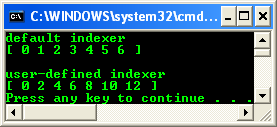< C++ .NET Properties 5 | Main | C++ .NET Properties 7 >
Properties 6
get me and set me!
What we have in this page?
More On Indexed Properties
An indexed property typically exposes a data structure that is accessed using a subscript operator. A default indexed property allows the user to access the data structure via the class name, whereas a user-defined indexed property requires the user to specify the property name to access the data structure. The following example shows how to use default and user defined indexed properties.
// property keyword, indexed property // compile with: /clr #include "stdafx.h"
using namespace System;
public ref class myClass { array<int>^ MyArr; public: // constructor, 7 is the array size myClass() { MyArr = gcnew array<int>(7); } // default indexer property int default[int] { int get(int index) { return MyArr[index]; } void set(int index, int value) { MyArr[index] = value; } } // user-defined indexer property int indexer1[int] { int get(int index) { return MyArr[index]; } void set(int index, int value) { MyArr[index] = value; } } };
int main() { myClass ^ MyC = gcnew myClass(); // use the default indexer Console::WriteLine("default indexer"); Console::Write("[ "); for (int i = 0; i < 7; i++) { MyC[i] = i; Console::Write("{0} ", MyC[i]); } Console::WriteLine("]"); // use the user-defined indexer Console::WriteLine(); Console::WriteLine("user-defined indexer"); Console::Write("[ "); for (int i = 0; i < 7; i++) { MyC->indexer1[i] = i * 2; Console::Write("{0} ", MyC->indexer1[i]); } Console::WriteLine("]"); return 0; }
Output: |

The following example shows how to call the default indexer through the this pointer.
// call the default indexer through this pointer
// compile with: /clr
#include "stdafx.h"
using namespace System;
value class Position
{
public:
Position(int x, int y) : position(gcnew array<int, 2>(100, 100))
{ this->default[x, y] = 1; }
property int default[int, int]
{
int get(int x, int y) { return position[x, y]; }
void set(int x, int y, int value) {}
}
private:
array<int, 2> ^ position;
};
int main()
{
return 0;
}
// No output
The following example shows how you can use DefaultMemberAttribute to specify the default indexer.
// This is the main DLL file.
// specify the default indexer
// compile with: /LD /clr
#include "stdafx.h"
#include "specify_default_indexer.h"
using namespace System;
[Reflection::DefaultMember("XXX")]
public ref struct Squares
{
property Double XXX[Double]
{
Double get(Double data) { return data*data; }
}
};
The following example uses the metadata created in the previous example.
// use the default indexer
// compile with: /clr
#include "stdafx.h"
using namespace System;
#using "specify_default_indexer.dll"
int main()
{
Squares ^ square = gcnew Squares();
System::Console::WriteLine("{0}", square[3]);
return 0;
}
Output:
9
Declaring and Using Static Properties
The following program example shows how to declare and use a static property. A static property can only access static members of its class.
// more on property keyword
// compile with: /clr
#include "stdafx.h"
using namespace System;
ref class StaticProperties
{
static int MyInt;
static int MyInt2;
public:
static property int Static_Data_Member_Property;
static property int Static_Block_Property
{
int get() { return MyInt; }
void set(int value) { MyInt = value; }
}
};
int main()
{
StaticProperties::Static_Data_Member_Property = 100;
Console::WriteLine("StaticProperties::Static_Data_Member_Property: {0}", StaticProperties::Static_Data_Member_Property);
StaticProperties::Static_Block_Property = 200;
Console::WriteLine("StaticProperties::Static_Block_Property: {0}", StaticProperties::Static_Block_Property);
return 0;
}
Output:
